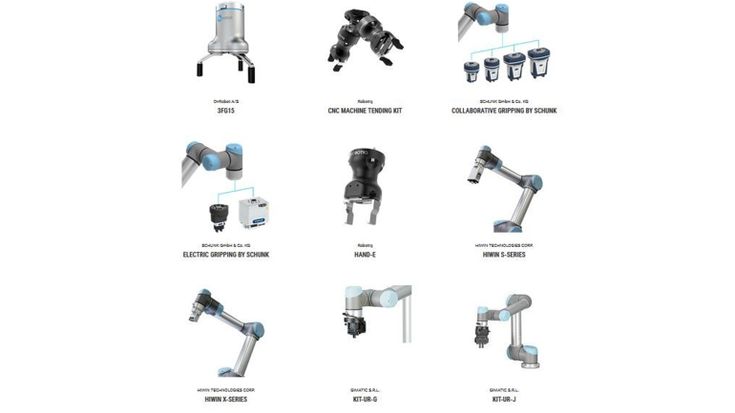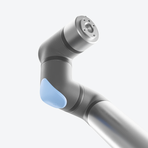In this article, we'll take a look at some of the UR certified electric and pneumatic grippers available through UR+ –a global ecosystem of components, software, and application kits that have been validated and certified to be mechanically, electrically and digitally compatible with cobots from Universal Robots.
Robot Gripper Showdown: Air Gripper vs. Electric Gripper

In this article, we'll take a look at some of the UR certified electric and pneumatic grippers available through UR+ –a global ecosystem of components, software, and application kits that have been validated and certified to be mechanically, electrically and digitally compatible with cobots from Universal Robots. We'll also compare the two types of grippers and their uses.
What is an air gripper and how does it work?
Also known as pneumatic grippers, air grippers use pressure from a compressed air supply system to supply the power required to move an inner piston, thereby opening and closing the gripper's pneumatic gripper fingers (or 'jaws').
Since the majority of manufacturing facilities already have access to compressed air, deploying pneumatic grippers is easy and cost-effective. One of the main benefits of pneumatic grippers is that they provide a high amount of gripping force in a small, light and low-cost package. For manufacturing facilities where space is at a premium, pneumatic grippers are an economical and ergonomic choice. They are also quite easy to maintain –once you have your pneumatic gripper working, it can provide millions of cycles without requiring maintenance.
Let's take a look at some of pneumatic robot gripper options available through UR+. (To see the entire UR+ gripper range, click here.)
SCHUNK offers an extensive range of UR-certified pneumatic grippers through the UR+ ecosystem. One of SCHUNK's most popular grippers is its Universal gripper PGN-plus-P –a 2-finger parallel gripper with permanent lubrication, large gripping force and high maximum moments thanks to multi-tooth guidance. This gripper is designed for handling workpieces in clean to slightly dirty environments. Also popular is SCHUNK's Universal gripper JGP –a compact 2-finger parallel gripper with T-slot guidance. This gripper is designed for use in many applications and environments and can be deployed in both clean and slightly dirty environments. For applications with special temperature, dirt and chemical resistance requirements, the Universal 3-Finger Centric Gripper is a good fit, plus, it has a high gripping force.

The Zimmer Group offers a wide range of UR-certified pneumatic grippers, including 2-jaw parallel-, 3-jaw concentric,- 2-jaw angular-, internal- and magnetic grippers as well cutting tongs. The series provides gripping forces from 30N for delicate operations to more than 2,000N for heavy-duty applications. Zimmer's 2-Jaw Parallel Gripper GPP5000 –Pneumatic, for example, combines powerful gripping, long gripper jaws and corrosion protection. An optional self-locking mechanism ensures safe gripping even in the event of power failure or E-Stop.

As with any type of gripper, when choosing a pneumatic gripper, it's important to consider different factors, such as the environmental conditions the gripper will be operating in. For example, while some pneumatic grippers are cleanroom certified, many are not due to the possibility of air leakages contaminating your workspace. Conversely, in dirty environments, you need to ensure that the gripper itself is shielded and protected from contaminants. The UR+ selection of pneumatic grippers includes links to this information, but to get the conversation started about the suitability of pneumatic grippers for your application, talk to one of our experts today.
What is an electric gripper and how does it work?
Also known as servo-electric grippers, electric grippers use an electric motor to control the gripper's fingers. Electric grippers are a popular choice for many cobot applications including machine tending and pick & place. Electric grippers usually come in two-jaw and three-jaw configurations, with 3 jaw grippers usually the preferred choice when round/cylindrical objects, such as tins or bottles need to be handled.
The defining feature of electric grippers is precise control. Most electric grippers come with microprocessors that enable you to vary gripping force and speed. Meanwhile, the addition of a force sensor enables electric grippers to understand the forces necessary for each task, helping it to handle different part types with ease.

Let's take a look at just some of the electric grippers available through UR+.
HIWIN's S-Series is a range of user friendly electric grippers that provide repeatability of ±0.1 mm with a 24mm stroke on both sides. Designed for easy set up, the UR+ Certified S-Series grippers offer plug and play compatibility with selected UR cobots and every gripper comes with its own built-in controller. Suitable for both single-gripper and dual-gripper setups, the S-Series is a great fit for handling elastic and fragile workpieces, such as electrical components, rubber material, glass material or shell structures.

OnRobot's RG6 is a flexible, easy to use electric gripper with a wide stroke of 160mm, enabling it to pick up a wide variety of items. Its strength and wide stroke make this gripper a good fit for a wide variety of applications from machine tending and assembly to packaging and palletizing. The FG6 comes with adjustable force and stroke features, automatic depth compensation, automatic payload setting and intuitive software that's fully integrated with your UR teach pendant, making set up and control easy, even for those with little or no previous robotics experience.

Meanwhile, Gimatic's Kit-UR-Jis an electric, parallel, 2-finger gripper Kit that uses Gimatic's MPRJ2253NP gripper and is compatible with UR3, UR5, UR10 and e-Series collaborative robots. Designed for easy install without any configuration, the Kit-UR-J has a stroke of 53mm and comes with embedded proximity switch functionality for gripping and end of stroke detection. This gripper is suitable for long stroke and tasks that require a fast opening/closing motion. The UR-J's URCap software enables the user to easily configure the device and a list of the work pieces to be gripped.

SCHUNK's Co-act gripper EGH is an electric, parallel gripper designed for handling, assembly and electronics tasks and for gripping small to medium-sized workpieces. Fully integrated and plug-and-play with all models of cobot from Universal Robots, the Co-act gripper EGH provides flexible stroke control through its easy to use URCap software. Additional flexible fingers are also available, should you require this option. An integrated status display keeps workers informed of the gripper's status.

The 3-Finger Gripper from Robotiq is a rugged, versatile electric gripper that open up to 155mm. Suitable for quality control, machine tending, assembly and pick&place applications, this fully metallic gripper is designed to adapt to the object's shape. Four modes –Pinch, Wide, Scissor and Basic-- allow you to easily set up your application, while the gripper's URCap software provides feedback from each finger and allows you to adjust the gripper's position speed and force. Robotiq's 3-Finger Gripper is compatible with all of Universal Robots' collaborative robots.

The Showdown
While electric grippers are getting more powerful every year, in general they tend to provide less gripping force than pneumatic grippers and they also tend to be more expensive. However, what electric grippers lack in force they more than make up for by providing users with fine control over the gripper's speed, force and position. UR Certified electric grippers allow you to easily and precisely define the position of the gripper's fingers.
Many electric grippers also provide 'detect grip' functionality, which tells whether a part has been successfully picked. Additionally, electric grippers allow you to precisely control the gripper's grip force and closing speed –functionality that is particularly important when handling fragile or delicate items. While most types of gripper typically operate on full stroke, you can partially open servo-electric grippers, which allows them to easily pick a wide range of parts of different sizes.
If you are selecting a gripper for a precision assembly tasks, an electric gripper will likely be a good fit. Similarly, part sorting processes require gripper adaptability to ensure parts can be sorted, especially those ranging in size or that are positioned differently from each other –while advanced pneumatic grippers can provide elements of this functionality, electric grippers are more flexible and are easier to adjust to changing object types.
Most factories will have access to an air supply, which simplifies the deployment of pneumatic grippers. However, since electric grippers don't require an air supply, deployment is even easier and in terms of operating costs, cheaper. If your application requires a clean environment, electric grippers may be the safer choice as they eliminate the potential for air leaks.
Choosing the right gripper for your application(s) depends on many factors, from the size, shape and weight of the item or items to be gripped to environmental conditions and your budget. Talk to one of our experts today to find out more!

- Universal Robots USA, Inc
- 27175 Haggerty Road, Suite 160
- 48377 Novi, MI